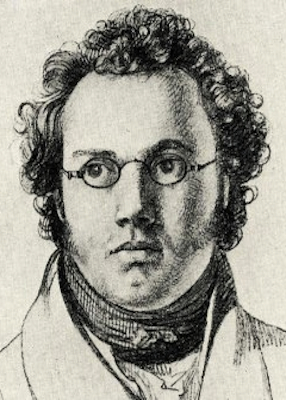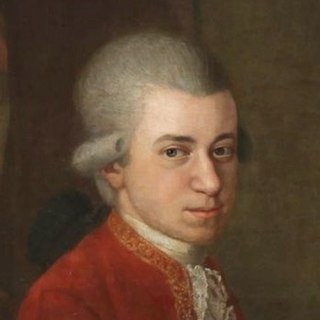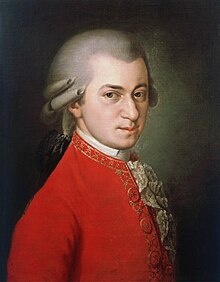
Eine kleine Nachtmusik, K. 525, is a 1787 composition for a chamber ensemble by Wolfgang Amadeus Mozart (1756–1791). The German title means "a little night music". The work is written for an ensemble of two violins, viola, cello and double bass, but is often performed by string orchestras. The serenade is one of Mozart's most famous works.

Joseph Haydn's Symphony No. 13 in D major was written in 1763 for the orchestra of Haydn's patron, Prince Nikolaus Esterházy, in Eisenstadt.

Wolfgang Amadeus Mozart completed his Symphony No. 41 in C major, K. 551, on 10 August 1788. The longest and last symphony that he composed, it is regarded by many critics as among the greatest symphonies in classical music. The work is nicknamed the Jupiter Symphony, probably coined by the impresario Johann Peter Salomon.

Ludwig van Beethoven's Symphony No. 1 in C major, Op. 21, was dedicated to Baron Gottfried van Swieten, an early patron of the composer. The piece was published in 1801 by Hoffmeister & Kühnel of Leipzig. It is not known exactly when Beethoven finished writing this work, but sketches of the finale were found to be from 1795.

The Symphony No. 104 in D major is Joseph Haydn's final symphony. It is the last of the twelve London symphonies, and is known as the London Symphony. In Germany it is commonly known as the Salomon Symphony after Johann Peter Salomon, who arranged Haydn's two tours of London, even though it is one of three of the last twelve symphonies written for Viotti's Opera Concerts, rather than for Salomon.

The Symphony No. 96 in D major, Hoboken I/96, was completed by Joseph Haydn in 1791 as part of the set of symphonies composed on his first trip to London. It was first performed at the Hanover Square Rooms in London on 11 March 1791. Although it is the fourth of the twelve London symphonies by number, it was actually the first one written and performed. It is popularly known as the Miracle Symphony.

Franz Schubert's Symphony No. 5 in B♭ major, D. 485, was written mainly in September 1816 and completed on 3 October 1816. It was finished six months after the completion of his previous symphony.

Symphony No. 35 in D major, K. 385, also known as the Haffner Symphony, was composed by Wolfgang Amadeus Mozart in 1782. It was commissioned by the Haffners, a prominent Salzburg family, for the occasion of the ennoblement of Sigmund Haffner the Younger. The Haffner Symphony should not be confused with the eight-movement Haffner Serenade, another piece Mozart wrote on commission from the same family in 1776.

The Violin Concerto No. 3 in G major, K. 216, was composed by Wolfgang Amadeus Mozart in Salzburg in 1775 when he was 19 years old. In a letter to his father, Mozart called it the "Straßburg-Concert". Researchers believe this epithet comes from the motive in the third movement's Allegretto in the central section, a local dance that already had appeared as a musette-imitating tune in a symphony by Carl Ditters von Dittersdorf.

Symphony No. 16 in C major, K. 128, was the first of three symphonies composed by Wolfgang Amadeus Mozart in May 1772 when Mozart was sixteen years old. This symphony is one of many written during the period in which Mozart stayed in Salzburg, between two trips to Italy. The autograph of the score is preserved in the Berlin State Library.
The Symphony No. 98 in B♭ major, Hoboken I/98, is the sixth of the twelve London symphonies composed by Joseph Haydn. It was completed in 1792 as part of the set of symphonies composed on his first trip to London. It was first performed at the Hanover Square Rooms in London on 2 March 1792. Some musicologists and historians interpret this symphony as Haydn’s tribute to his friend Mozart who had died on 5 December 1791.
Symphony No. 88 in G major was written by Joseph Haydn, for the orchestra of Esterháza under the benevolent Prince Nikolaus Esterhazy. It is notably the first of his symphonies written after the completion of the six Paris symphonies in 1786.

Symphony No. 34 in C major, K. 338, was written by Wolfgang Amadeus Mozart in 1780, and completed on 29 August that year.

The Symphony No. 32 in G major, K. 318, was written by Wolfgang Amadeus Mozart in 1779, after his return from Paris.

The Symphony No. 33 in B♭ major, K. 319, was written by Wolfgang Amadeus Mozart, and dated on 9 July 1779.

Symphony No. 1 in C minor, Op. 11, is a work by Felix Mendelssohn, completed on 31 March 1824, when the composer was only 15 years old. The autograph score was published in 1831.

The Symphony No. 8 in D major,, by Wolfgang Amadeus Mozart is dated 13 December 1768. Mozart wrote the symphony in Vienna, when he was twelve years old, at a time when he and his family were already due to have returned home to Salzburg. In a letter to his friend in Salzburg, Johann Lorenz Hagenauer, Leopold Mozart says of the delay that "we could not bring our affairs to a conclusion earlier, even though I endeavored strenuously to do so." The autograph of the Symphony No. 8 is today preserved in the Berlin State Library.

Wolfgang Amadeus Mozart wrote Symphony No. 30 in D major, K. 202/186b in Salzburg, completing it on 5 May 1774.
Divertimento No. 11 or Divertimento in D, K. 251, is a composition by Wolfgang Amadeus Mozart. It was written in July 1776 in Salzburg, possibly for the name day of Mozart's sister, Nannerl on July 26 or her birthday on July 30. The work is scored for oboe, two horns, two violins, viola and double bass.
The bassoon repertoire consists of pieces of music composed for bassoon as a principal instrument that may be performed with or without other instruments. Below is a non-exhaustive list of major works for the bassoon.












